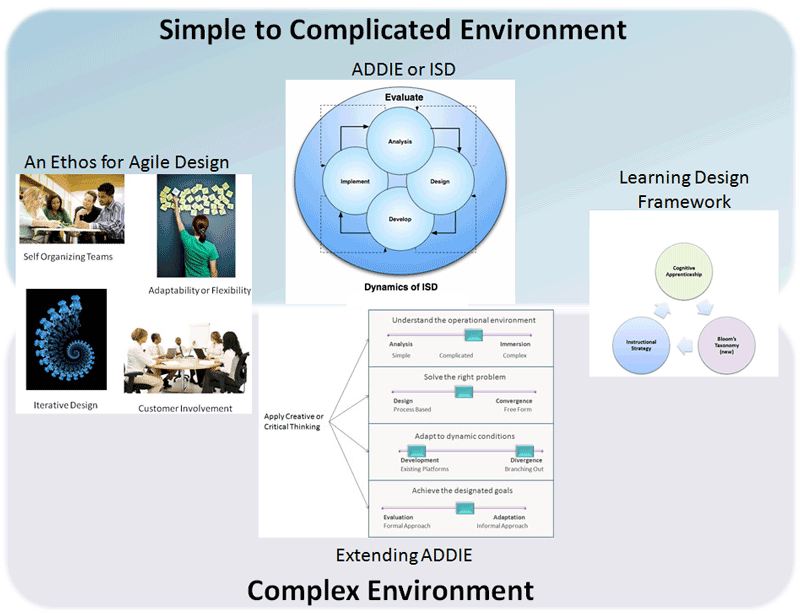Note: This site is moving to KnowledgeJump.com. Please reset your bookmark.
Learning Strategies or
Instructional Strategies
Learning or instructional strategies determine the approach for achieving the learning objectives and are included in the pre-instructional activities, information presentation, learner activities, testing, and follow-through. The strategies are usually tied to the needs and interests of students to enhance learning and are based on many types of learning styles (Ekwensi, Moranski, &Townsend-Sweet, 2006).
Thus the learning objectives point you towards the instructional strategies, while the instructional strategies will point you to the medium that will actually deliver the instruction, such as elearning, self-study, classroom, or OJT. However, do not fall into the trap of using only one medium when designing your course. . . use a blended approach.
Although some people use the terms interchangeably, objectives, strategies, and media, all have separate meanings. For example, your learning objective might be "Pull the correct items for a customer order;" the instructional strategies are a demonstration, have a question and answer period, and then receive hands-on practice by actually performing the job, while the media might be a combination of elearning and OJT.
The Instructional Strategy Selection Chart shown below is a general guideline for selecting the learning strategy. It is based on Bloom's Taxonomy (Learning Domains). The matrix generally runs from the passive learning methods (top rows) to the more active participation methods (bottom rows. Bloom's Taxonomy (the right three columns) runs from top to bottom, with the lower level behaviors being on top and the higher behaviors being on the bottom. That is, there is a direct correlation in learning:
- Lower levels of performance can normally be taught using the more passive learning methods.
- Higher levels of performance usually require some sort of action or involvement by the learners.
Instructional Strategy Selection Chart
Instructional Strategy |
Cognitive Domain |
Affective Domain |
Psychomotor Domain |
| Lecture, reading, audio/visual, demonstration, or guided observations, question and answer period |
1. Knowledge |
1. Receiving phenomena |
1. Perception
2. Set |
| Discussions, multimedia CBT, Socratic didactic method, reflection. Activities such as surveys, role playing, case studies, fishbowls, etc. |
2. Comprehension 3. Application |
2. Responding to phenomena |
3. Guided response
4. Mechanism |
| On-the-Job-Training (OJT), practice by doing (some direction or coaching is required), simulated job settings (to include CBT simulations) |
4. Analysis |
3. Valuing |
5. Complex response |
| Use in real situations. Also may be trained by using several high level activities coupled with OJT. |
5. Synthesis |
4. Organize values into priorities |
6. Adaptation |
Normally developed on own (informal learning) through self-study or learning through mistakes, but mentoring and coaching can speed the process. |
6. Evaluation |
5. Internalizing values |
7. Origination |
The chart does not cover all possibilities, but most activities should fit in. For example, self-study could fall under reading, audio visual, and/or activities, depending upon the type of program you design.
Next Step
Reference
Bloom B. S. (1956). Taxonomy of Educational Objectives, Handbook I: The Cognitive Domain. New York: David McKay Co Inc.
Ekwensi, F., Moranski, J., & Townsend-Sweet, M., (2006). E-Learning Concepts and Techniques. Bloomsburg University of Pennsylvania's Department of Instructional Technology. 5.1 Instructional Strategies for Online Learning. Retrieved November 8, 2008: http://iit.bloomu.edu/Spring2006_eBook_files/ebook_spring2006.pdf
Krathwohl, D. R., Bloom, B. S., & Masia, B. B. (1973). Taxonomy of Educational Objectives, the Classification of Educational Goals. Handbook II: Affective Domain. New York: David McKay Co., Inc.
Simpson E. J. (1972). The Classification of Educational Objectives in the Psychomotor Domain. Washington, DC: Gryphon House.


